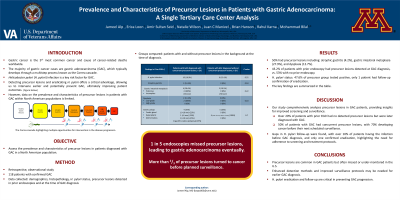Sunday Poster Session
Category: Stomach
P1618 - Prevalence and Characteristics of Precursor Lesions in Patients with Gastric Adenocarcinoma: A Single Tertiary Care Center Analysis
Sunday, October 27, 2024
3:30 PM - 7:00 PM ET
Location: Exhibit Hall E

Has Audio

Jameel Alp, MD
University of Minnesota
Minnetonka, MN
Presenting Author(s)
Jameel Alp, MD1, Erica Loon, DO2, Amir Sultan Seid, MD2, Natalie Wilson, MD2, Juan C. Manivel, MD3, Brian Hanson, MD3, Rahul Karna, MD2, Mohammad Bilal, MD4
1University of Minnesota, Minnetonka, MN; 2University of Minnesota, Minneapolis, MN; 3Minneapolis VA Health Care System, Minneapolis, MN; 4University of Minnesota and Minneapolis VA Health Care System, Minneapolis, MN
Introduction: Gastric adenocarcinoma (GAC) is associated with a precursor sequence involving chronic active gastritis, atrophic gastritis (AG), gastric intestinal metaplasia (GIM), dysplasia, and eventually GAC. However, the prevalence of precursor lesions (PLs) in patients with GAC is not known. We aimed to evaluate the prevalence and characteristics of PLs of GAC.
Methods: We conducted a retrospective analysis of all GAC cases diagnosed at our institution from 2003 to 2023. We collected demographic, clinical, endoscopic, histopathologic, and oncological data. Our primary outcome was the prevalence of PLs in patients diagnosed with GAC. Secondary outcomes included identifying the proportion of PLs discovered prior to and at the time of GAC diagnosis.
Results: The study included 118 patients. The mean age was 72.5 years, and 97.4% were male. Among these, 59 patients (50%) had concurrent background PLs at the time of GAC diagnosis: atrophic gastritis in 5 patients (4.2%), GIM in 33 patients (28%), and dysplasia in 15 patients (12.7%). 62.7% (37/59) of these patients underwent previous esophagogastroduodenoscopy (EGD), and only 27.1% (16/59) had a history of PLs. Background GIM was observed at the same rate in patients with history of EGD than those without prior EGD (50% [8/16] vs 58.1% [25/43], p = 0.57). Similarly, background dysplasia was observed at same rate in patients with history of EGD than those without EGD (25% [4/16 vs 25.6% [11/43], p = 0.96). Among patients with a prior history of PLs, 70% developed GAC prior to next recommended surveillance EGD: AG 50% (1/2), GIM 66.6% (4/6), and dysplasia 100% (2/2). 33% (39/118) were previously tested for Helicobacter pylori, with 10.1% positivity (12/118), 9.3% (11/118) treatment rate and 0.8% (1/118) with test of cure.
Discussion: Our study highlights two broad themes. Firstly, over 20% of patients who underwent EGDs prior to their GAC diagnosis showed no PLs but subsequently developed GAC with PLs in the background, suggesting that these PLs may have been missed. Similar rates of background PLs in patients with and without a prior EGD, reaffirms possibility of missed lesions. Secondly, 70% of patients with PLs identified on prior EGD developed GAC before their next scheduled surveillance EGD. This raises concerns about inadequate sampling or missed opportunities for intervention (endoscopic or surgical). These findings reinforce the need for quality metrics on EGD.
Note: The table for this abstract can be viewed in the ePoster Gallery section of the ACG 2024 ePoster Site or in The American Journal of Gastroenterology's abstract supplement issue, both of which will be available starting October 27, 2024.
Disclosures:
Jameel Alp, MD1, Erica Loon, DO2, Amir Sultan Seid, MD2, Natalie Wilson, MD2, Juan C. Manivel, MD3, Brian Hanson, MD3, Rahul Karna, MD2, Mohammad Bilal, MD4. P1618 - Prevalence and Characteristics of Precursor Lesions in Patients with Gastric Adenocarcinoma: A Single Tertiary Care Center Analysis, ACG 2024 Annual Scientific Meeting Abstracts. Philadelphia, PA: American College of Gastroenterology.
1University of Minnesota, Minnetonka, MN; 2University of Minnesota, Minneapolis, MN; 3Minneapolis VA Health Care System, Minneapolis, MN; 4University of Minnesota and Minneapolis VA Health Care System, Minneapolis, MN
Introduction: Gastric adenocarcinoma (GAC) is associated with a precursor sequence involving chronic active gastritis, atrophic gastritis (AG), gastric intestinal metaplasia (GIM), dysplasia, and eventually GAC. However, the prevalence of precursor lesions (PLs) in patients with GAC is not known. We aimed to evaluate the prevalence and characteristics of PLs of GAC.
Methods: We conducted a retrospective analysis of all GAC cases diagnosed at our institution from 2003 to 2023. We collected demographic, clinical, endoscopic, histopathologic, and oncological data. Our primary outcome was the prevalence of PLs in patients diagnosed with GAC. Secondary outcomes included identifying the proportion of PLs discovered prior to and at the time of GAC diagnosis.
Results: The study included 118 patients. The mean age was 72.5 years, and 97.4% were male. Among these, 59 patients (50%) had concurrent background PLs at the time of GAC diagnosis: atrophic gastritis in 5 patients (4.2%), GIM in 33 patients (28%), and dysplasia in 15 patients (12.7%). 62.7% (37/59) of these patients underwent previous esophagogastroduodenoscopy (EGD), and only 27.1% (16/59) had a history of PLs. Background GIM was observed at the same rate in patients with history of EGD than those without prior EGD (50% [8/16] vs 58.1% [25/43], p = 0.57). Similarly, background dysplasia was observed at same rate in patients with history of EGD than those without EGD (25% [4/16 vs 25.6% [11/43], p = 0.96). Among patients with a prior history of PLs, 70% developed GAC prior to next recommended surveillance EGD: AG 50% (1/2), GIM 66.6% (4/6), and dysplasia 100% (2/2). 33% (39/118) were previously tested for Helicobacter pylori, with 10.1% positivity (12/118), 9.3% (11/118) treatment rate and 0.8% (1/118) with test of cure.
Discussion: Our study highlights two broad themes. Firstly, over 20% of patients who underwent EGDs prior to their GAC diagnosis showed no PLs but subsequently developed GAC with PLs in the background, suggesting that these PLs may have been missed. Similar rates of background PLs in patients with and without a prior EGD, reaffirms possibility of missed lesions. Secondly, 70% of patients with PLs identified on prior EGD developed GAC before their next scheduled surveillance EGD. This raises concerns about inadequate sampling or missed opportunities for intervention (endoscopic or surgical). These findings reinforce the need for quality metrics on EGD.
Note: The table for this abstract can be viewed in the ePoster Gallery section of the ACG 2024 ePoster Site or in The American Journal of Gastroenterology's abstract supplement issue, both of which will be available starting October 27, 2024.
Disclosures:
Jameel Alp indicated no relevant financial relationships.
Erica Loon indicated no relevant financial relationships.
Amir Sultan Seid indicated no relevant financial relationships.
Natalie Wilson indicated no relevant financial relationships.
Juan Manivel indicated no relevant financial relationships.
Brian Hanson: Motus GI – Consultant.
Rahul Karna indicated no relevant financial relationships.
Mohammad Bilal: Boston Scientific – Consultant. Cook endoscopy – Speakers Bureau.
Jameel Alp, MD1, Erica Loon, DO2, Amir Sultan Seid, MD2, Natalie Wilson, MD2, Juan C. Manivel, MD3, Brian Hanson, MD3, Rahul Karna, MD2, Mohammad Bilal, MD4. P1618 - Prevalence and Characteristics of Precursor Lesions in Patients with Gastric Adenocarcinoma: A Single Tertiary Care Center Analysis, ACG 2024 Annual Scientific Meeting Abstracts. Philadelphia, PA: American College of Gastroenterology.

